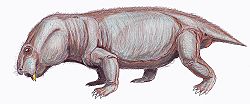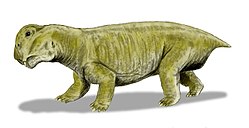| Pristerodon Temporal range: Late Permian | |
|---|---|
 | |
| Skull at the Museum für Naturkunde, Berlin | |
| Scientific classification | |
| Domain: | Eukaryota |
| Kingdom: | Animalia |
| Phylum: | Chordata |
| Clade: | Synapsida |
| Clade: | Therapsida |
| Suborder: | † Anomodontia |
| Clade: | † Dicynodontia |
| Family: | † Eumantellidae |
| Genus: | † Pristerodon Huxley, 1868 |
| Type species | |
| †Pristerodon mackayi Huxley, 1868 | |
| Synonyms | |
| |
Pristerodon is an extinct genus of dicynodont therapsid from the Late Permian of South Africa, Zambia and India.





